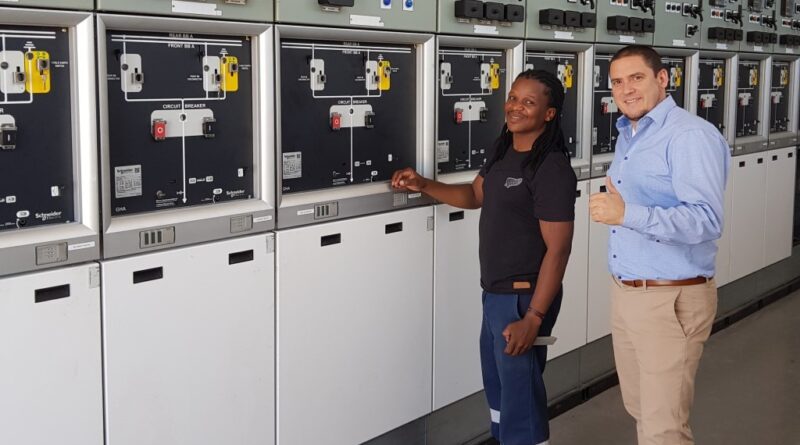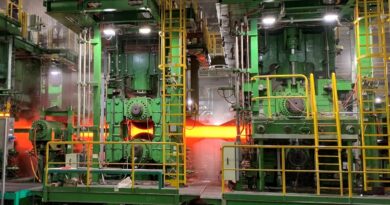MV switchgear replacement contract at Tutuka power plant
Eskom has awarded ACTOM a R1.18-bln contract to perform comprehensive MV switchgear replacement at Tutuka power station near Standerton in Mpumalanga.
The six-year contract, one of the largest-value contracts ever to be won by the group, was signed by Eskom on 5 December 2019, after a prolonged tendering and negotiation process dating back to mid-2016.
It involves replacing and upgrading the medium-voltage switchgear and all associated equipment and systems in the power station’s six generator units and in its common plant.
Tutuka, one of many of Eskom’s coal-fired power plants that have been in operation for more than 30 years, has been selected by the utility for comprehensive refurbishment to extend the life of the station.
Five ACTOM divisions are involved in the project, with ACTOM MV Switchgear as main contractor and ACTOM Contracting taking overall responsibility for the project management and coordination of the contract as a whole.
The contract – divided into six contract packages allocated to ACTOM MV Switchgear, ACTOM Protection & Control, Static Power and ACTOM HVAC Systems – comprises:
- The first contract package – designated Package 3A – covers medium voltage switchgear, which ACTOM MV Switchgear together with its France-based international technology partner Schneider Electric, will manufacture, supply, assemble and install. It involves the replacement of a total of 615 panels comprising 395 of Schneider Electric’s well-proven PIX air-insulated switchgear (AIS) and 220 units of its GHA branded gas-insulated switchgear (GIS), which is also widely in use and well-proven worldwide. Both the PIX and GHA switchgear will be supplied with rated voltages of 17.5kV (for use at 11kV) and 12kV (for use at 3.3kV). The equipment to be provided by ACTOM MV Switchgear will also be used for provision of power for the planned refurbished and upgraded dust-collection and gas-cleaning filtration plant that is due to replace the existing facility at Tutuka.
- ACTOM Protection & Control (P&C) is responsible for three contract packages – namely Packages 3B, 3C and 3E – covering the protection, automation and control & instrumentation (C&I) systems respectively. Here again Schneider Electric features as the main international technology partner, as it is responsible for the manufacture and supply of both the protection and automation equipment due to replace the power station’s existing systems. These will comprise Schneider’s well-known MiCOM protection IEDs and its similarly widely-used C264 and PACiS automation system. The replacement equipment for internal arc protection within the medium-voltage switchgear, however, is to be manufactured by P&C’s other international protection systems technology partner, Arcteq of Finland, which is contracted to supply its internal arc protection units. The C&I package for which P&C is responsible involves a partnership arrangement with international companies ABB and Yokogawa, which will produce and supply the required control and instrumentation engineering equipment respectively for Tutuka’s units 4, 5 & 6 and the common plant. The manufacture, supply and installation of the C&I equipment for units 1, 2 & 3 are not within the scope of the ACTOM contract.
- Static Power is responsible for Package 3D of the contract, involving the supply and installation of all standby battery chargers for the above-mentioned systems. The chargers and battery cabinets are 100% locally designed, engineered and manufactured, with ALCAD Vantex Ultra Low maintenance valve regulated Nickel cadmium battery banks providing four-hour backup time. Static Power’s scope also includes the supply of uninterrupted power supply (UPS) systems (one of which is a locally manufactured modular UPS and another an imported Statron UPS) for automation installations.
- ACTOM HVAC Systems’ contribution – Package 3F of the contract – accounts for 25% of the contract value and consists of an extensive upgrade of the existing HVAC plant throughout the power station and the provision of nine new HVAC systems for existing outside plant substations, resulting in a total installed capacity of just over 9MW of mechanical cooling. Major equipment to be supplied are 14 new water-cooled chillers for run and standby conditions totalling 4203kW cooling capacity and three closed circuit central cooling towers with a total heat rejection of 5550kW. 2.5 km of new steel pipework for the chilled water and condenser water systems will be installed throughout the power station. ACTOM HVAC Systems will design, supply, install and commission 22 low-voltage MCC switchboards to operate and control the HVAC plant equipment. A central building management system will be used to effectively manage and control the new HVAC system. New controls consisting of sensors, PLC’s and field equipment will ensure an efficient system of control.
Kevin Saunders, ACTOM Contracting’s Contracts Manager and Principal Project Manager for the total Tutuka refurbishment contract, who the respective contract managers responsible for each of the six contract packages will report to for the duration of the contract, said:
“We devised the overall management structure to handle the contract both on and off site. Among the things this covers are the overall coordination of the business units involved and a single point of contact with Eskom. It is also aimed at ensuring that there is no duplication of facilities within the group.
“All the design issue responsibilities rest with the individual business units, including each being responsible for the interface between them and the other units,” he added.
ACTOM Contracting’s contractual and project management responsibilities include contractual due diligence, scheduling and time management and the commercial and financial aspects of the contract.
In addition, it is responsible for human resources (HR) and industrial relations (IR) functions for the entire contract, as well as attending to all quality, safety, health and environmental requirements.
“We also have to conduct the scheduling and timing to align with the outages, which involves fitting in with Eskom’s requirement of when outages take place,” Saunders commented.




